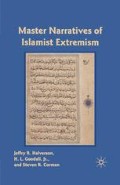Abstract
The emergence of Muslim suicide-bombers in the final decades of the twentieth century transformed otherwise obscure Islamic traditions(ahadith) into a topic of sensational public interest, as well as ridicule. According to these traditions, Muslim men that die waging jihad against the enemies of Islam will be rewarded by Allah in heaven (jannah) as martyrs (shuhada) and receive seventy-two virgins to enjoy in blissful ecstasy. This notion seems to be particularly attractive to young males who live in otherwise sexually repressive societies (e.g., Saudi Arabia, Afghanistan), perhaps due to stifling economic limitations, and are yet to marry.
Access this chapter
Tax calculation will be finalised at checkout
Purchases are for personal use only
Preview
Unable to display preview. Download preview PDF.
Notes
See Bruce Lincoln, Holy Terrors: Thinking about Religion after September 11 (Chicago: University of Chicago, 2003).
Sigmund Freud, The Future of an Illusion, trans. James Strachey (New York: W. W. Norton, 1961), 38.
Maya Müller, Robert E. Shillenn, Jane McGary, “Afterlife,” The Oxford Encyclopedia of Ancient Egypt, ed. Donald B. Redford (New York: Oxford University Press, 2001, 2005); The Oxford Encyclopedia of Ancient Egypt: (e-reference edition), Oxford University Press, Arizona State University. 25 January 2010. http://www.oxford-ancientegypt.com/entry?entry=t176.e0013.
Stephen G. J. Quirke, “Judgment of the Dead,” The Oxford Encyclopedia of Ancient Egypt, ed. Donald B. Redford (Oxford University Press, 2001, 2005); The Oxford Encyclopedia of Ancient Egypt: (e-reference edition), Oxford University Press, Arizona State University. 25 January 2010. http://www.oxford-ancientegypt.com/entry?entry=t176.e0367.
Jacobus Van Dijk, “Paradise,” The Oxford Encyclopedia of Ancient Egypt, ed. Donald B. Redford (Oxford University Press, 2001, 2005); The Oxford Encyclopedia of Ancient Egypt: (e-reference edition), Oxford University Press, Arizona State University. 25 January 2010. http://www.oxford-ancientegypt.com/entry?entry=t176.e0550.
Stephen L. Harris, Understanding the Bible: Fifth Edition (Mountain View, CA: Mayfield Publishing, 2000), 22.
See, e.g., Lawrence H. Mills, Zarathushtra, Philo, the Achaemenids and Israel (New York: AMS Press, 1977).
Mary Boyce, A History of Zoroastrianism: The Early Period (Leiden: E. J. Brill, 1996), 237–239.
Mary Boyce, A History of Zoroastrianism: The Early Period (Leiden: E. J. Brill, 1996), 236.
A. J. Wensinck, “Hur,” Encyclopedia of Islam, Second Edition, ed. P. Bearman, Th. Bianquis, C. E. Bosworth, E. van Donzel, and W. P. Heinrichs (Leiden: E. J. Brill, 2009); Brill Online, Arizona State University, 22 December 2009. http://www.brillonline.nl.ezproxyl.lib.asu.edu/subscriber/entry?entry=islam_SIM-2960.
W. H. C. Frend, Martyrdom and Persecution in the Early Church (1965)
Werblowsky and Wigoder, The Oxford Dictionary of the Jewish Religion (New York: Oxford University Press, 1997) 444
Samuel Z. Klausner, “Martyrdom,” in The Encyclopedia of Religion, Vol. 9, ed. Mircea Eliade (New York: Macmillan, 1987), 230–237.
This includes being killed for preaching the message of Islam, speaking the truth in defiance of a tyrant, refusing to compromise ones faith under compulsion or torture, et cetera. See E. Kohlberg, “Shahid,” in The Encyclopedia of Islam: New Edition, Vol. IX, ed. C. E. Bosworth, E. Van Donzel, W. P. Heinrichs, and G. Lecomte (Leiden: E. J. Brill, 1997), 203–207.
See Martin Lings, Muhammad (Cambridge: The Islamic Texts Society, 1991), 79–80.
B. Todd Lawson, “Martyrdom,” in The Oxford Encyclopedia of the Modem Islamic World, Vol. 3, ed. John L. Esposito (New York: Oxford University Press, 1995), 58.
Bruce Lincoln, Holy Terrors: Thinking about Religion after September 11 (Chicago: University of Chicago, 2003), 86.
Copyright information
© 2011 Jeffry R. Halverson, H. L. Goodall Jr., and Steven R. Corman
About this chapter
Cite this chapter
Halverson, J.R., Goodall, H.L., Corman, S.R. (2011). Seventy-Two Virgins. In: Master Narratives of Islamist Extremism. Palgrave Macmillan, New York. https://doi.org/10.1007/978-0-230-11723-5_14
Download citation
DOI: https://doi.org/10.1007/978-0-230-11723-5_14
Publisher Name: Palgrave Macmillan, New York
Print ISBN: 978-1-349-29186-1
Online ISBN: 978-0-230-11723-5
eBook Packages: Palgrave Political & Intern. Studies CollectionPolitical Science and International Studies (R0)

